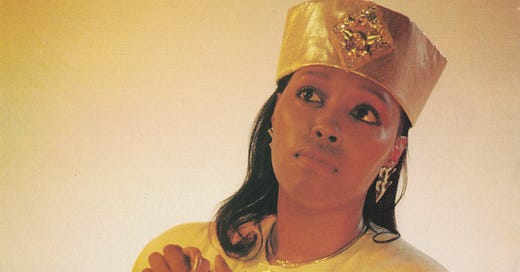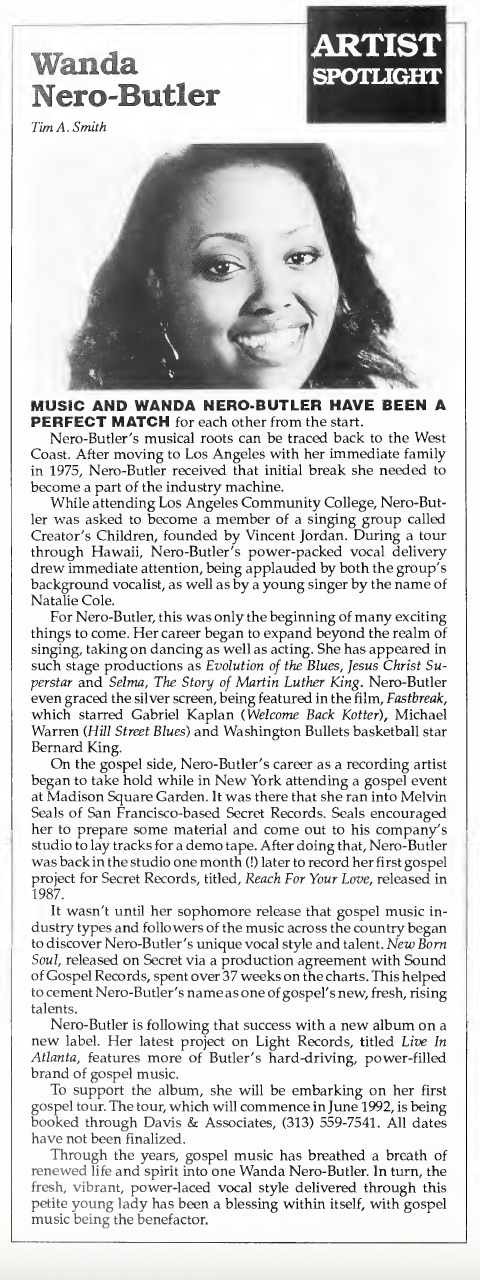Wanda Nero Butler Goes Higher
The artist once dubbed The Gospel Princess shares memories of her early career and the ways her understanding of the message in that music has expanded.
I was in high school when Wanda Nero Butler’s Live in Atlanta came out. I worked in our local Christian bookstore and had the opportunity to talk with label reps about new releases, and they usually left us with demos or pre-release copies. I was a fan of label owner/musician/producer Melvin Seals’ work, especially the 1990 release From The Inside Out which he’d produced on Arvis Strickling-Jones, a singer/songwriter/choir director from the Bay Area. When I saw Seals’ name on the Wanda Nero Butler cassette that had been left, I couldn’t wait to hear it.
For context—it was an incredible year for gospel music. There were some huge gospel releases: He Lives by Lashun Pace (then Shun Pace Rhodes), the final album by Rev. James Cleveland & the LA Gospel Messengers, Dorothy Norwood’s Live with the Northern California GMWA Mass Choir (which contained the massive hit “Victory is Mine”) and John P. Kee & the New Life Community Choir’s Wash Me were just a few of the blockbuster albums. And in the middle of that, Wanda Nero Butler came kicking through with an album that doubled the punch of her sophomore album, New Born Soul.
When I heard Wanda Nero Butler’s Live in Atlanta, it became one of my most played albums and has remained a staple in my life. Talking with her about the album has been on my bucket list…and during the early part of the pandemic, we made it happen…and I’m finally sharing it. When Wanda and I talked, the album had been unavailable since the nineties—but late last year, it was quietly re-released digitally. I was grateful I’d held onto our interview until just the right moment.
Wanda is a child of the Spiritual Church (which is a major part of my work in the forthcoming New York Community Choir book), born in the Bay Area to Bishop E.I. and Rev. Barbara Nero. In her senior year of high school, the Neros moved to Los Angeles where they pastored another church. You can see and hear Wanda in her youth in the below clip at her father’s later ministry in Detroit, the Landmark Temple of Deliverance.
The late Tim A. Smith, a noted gospel music journalist, wrote the feature below that summarizes the beginnings of Wanda’s professional career both as an actress and singer, and how she came to the attention of Melvin Seals, a former musician at her father’s church, who quickly signed her to his Secret Records imprint.
Her debut album, Reach For His Love, was released in 1987, a contemporary gospel project recorded in the confines of the studio—a new challenge for a singer adept in the ways of the Spirit and connecting with a live audience. We discussed the experience of learning the differences between recording for a studio project and singing live.
With 1989’s New Born Soul: Live in San Francisco, however, she broke out of the constraints of the studio and showed gospel music lovers what she was made of. With a band comprised of Kevin Bond, Joel Smith and Jonathan Dubose (at the time noted for their work within the Hawkins Family), a choir (which included former James Cleveland Singer, Gene Viale) directed by the aforementioned Arvis Strickling-Jones and Kevan Peabody, the gospel community took notice and she landed a Billboard charting album and a radio hit with the album’s title track.
Wanda graciously recalled the experience of collaborating with Arvis in the clip below. Below it, you’ll find a video from my own VHS collection of Wanda on Bobby Jones Gospel performing the album’s title track for ten glorious minutes.
When Live in Atlanta hit, New Born Soul had been on Billboard’s Top Gospel Albums chart for a whopping 73 weeks. But Live in Atlanta swiftly charted as well, peaking at the #23 position. In the third interview excerpt, Wanda shares what Ann Nesby and Kelly Price had to do with the recording and heralds the contributions of Kevan Peabody, Victor Beauchamp and Melvin Seals.
Shortly after Live in Atlanta, Light Records closed its doors—a monumental ending for a number of gospel artists. Wanda seized the moment and began to produce her own work, releasing her most successful albums with Sound of Gospel, who’d distributed her first two albums with Secret Records. She had a number of hits, with one of the most significant being a congregational song composed by her father, “Hey Ya’ll.”
In our final segment, we discuss her return to theater after “Hey Ya’ll” and the spiritual journey that shifted her into ministry focused on expanded consciousness and one that is also affirming of LGBTQI+ people.
God’s Music Is My Life is a free subscription service, but your support is appreciated for this and the expanded work that I do a historian and preservationist of gospel music history. To contribute, please support the GoFundMe that is helping to make the New York Community Choir book possible.






"Church it out!" Another in depth, inspiring portrait of an brilliant musician and beautiful human being! Love the interviews and am in the process of listening to all the songs!